Tara Chevrestt's Blog, page 23
May 1, 2015
Queen of Sparta by T. S. Chaudhry
 Author T.S. Chaudhry offers a new spin on Spartan history in his novel, THE QUEEN OF SPARTA. In the book, Queen Gorgo, the wife of the courageous Spartan leader, Leonidas, surreptitiously organizes the Greek resistance against the invasion of the mighty Persian king, Xerxes, and his massive army. Although founded on the writings of historian, Herodotus, Chaudhry’s revision of the 480 B.C. invasion challenges readers to imagine the brilliant and politically savvy Queen Gorgo as the Spartan leader who wielded her power with stealth and cunning to end the Persian occupation of Greece.
Author T.S. Chaudhry offers a new spin on Spartan history in his novel, THE QUEEN OF SPARTA. In the book, Queen Gorgo, the wife of the courageous Spartan leader, Leonidas, surreptitiously organizes the Greek resistance against the invasion of the mighty Persian king, Xerxes, and his massive army. Although founded on the writings of historian, Herodotus, Chaudhry’s revision of the 480 B.C. invasion challenges readers to imagine the brilliant and politically savvy Queen Gorgo as the Spartan leader who wielded her power with stealth and cunning to end the Persian occupation of Greece.Gorgo devises a strategy using espionage and diplomacy, in addition to Sparta’s military might, to defeat the Persians and drive them out of Greece. During the last battle of the war, Prince Sherzada, a Saka, is captured while fighting on the Persian side. He is imprisoned by Gorgo, who has vowed to kill him. However, an unexpected alliance blooms between Gorgo and Sherzada, based on common perceptions and a shared dark secret. As allies, the queen and prince face new dangers from within Sparta that threaten the safety of Gorgo and her young son, the king.
As the story progresses, Queen Gorgo must choose between confronting the reactionary forces within Sparta directly or saving her life and the life of her child.
***REVIEW***
I do not like signing up for book tours, only to dislike the book, especially when I'm sent a paperback copy. Unfortunately, I did not like this one much...for a couple of reasons. As a result, this review is no longer part of the tour and I'm posting it on my own time.
-The blurb makes it sound like a novel about Gorgo, this amazing warrior queen. And she is amazing, what bits reside on her. Truth is, the story isn't about her but this never-ending battle. It's just battle after battle after battle, war strategy after strategy. I quickly grew bored and frustrated. I'm not into battle details.
-The parts featuring the awesome Gorgo time jump all over the place. The book starts in one setting, goes back a year (the main setting for the book), then it goes back three years, then back to the year before the beginning, then back ten months, then back to the year before and then back 11 years...
--I didn't like and couldn't care less about the Persian man's POV- Sherzada. That is all battle stuff.
--LOTS of telling, very little showing.
Conclusion: This isn't a novel about Gorgo, the amazing warrior queen, but a summary of battles between Spartans and Persians.
I'm thankful for the chance to read this though and sorry I didn't like it more.

Published on May 01, 2015 00:00
April 30, 2015
Eighteen Acres (Charlotte Kramer #1) by Nicolle Wallace
 This is going to be a short review. While I enjoyed the book for the most part, it didn't really impact me much, neither in a good way nor a bad.
This is going to be a short review. While I enjoyed the book for the most part, it didn't really impact me much, neither in a good way nor a bad.In this novel, we me Charlotte Kramer, the first woman president of the U.S. This series caught my eye on Edelweiss where book three was posted. I picked this up so I would understand what was going on in book three and because it interested me.
It felt strange to me, this novel, like it was a sequel. But this is book one. I liked what there was of Charlotte, but the book didn't really get that "into" her. She's like a ship passing through in the night. I think I would have preferred a story about her, what made her strive for the presidency, what being the first woman running was like, the difficulties it made within her family, her goals for her term...but no, we're just thrown into the middle of her 8 years.
Instead the story focused on Melanie, her adviser, a successful woman getting a bit burned out. And this awful reporter named Dale who only seems to want the president's husband when he's her husband. And you could say Dale gets rewarded for diddling the president's husband and this made the book even stranger.
There was a brief scandal around a helicopter crash. There's a new campaign...and a new character is introduced that seems fiery and interesting, much more so than stoic, robotic Charlotte. And her name is Tara! What a great name!
And despite the fact I lost interest in this by the ending, I was going to read book three because of this interesting VP named Tara..only to discover she didn't make into book three because of stuff that happened in book two. So I'm just not going to bother. I'm afraid Dale and Melanie don't interest me that much and Charlotte seems to get the backburner despite her role.
I acquired this via Paperback Swap.

Published on April 30, 2015 00:00
April 29, 2015
The House of Eliott, Season One: Two Strong Women Start a Fashion House in the 20s
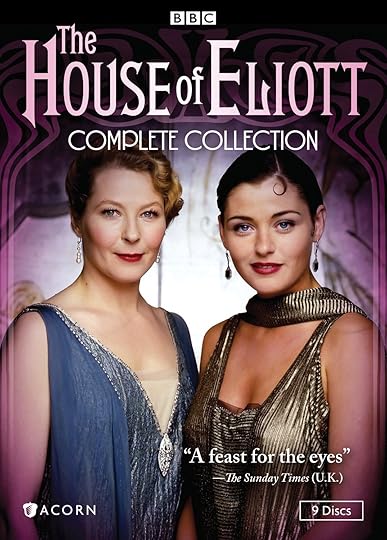 I actually bought the entire three season, the collection, but golly, that'd make a long post. And after watching 13, 14 episodes, I'm taking a break to watch some other things before I start season two.
I actually bought the entire three season, the collection, but golly, that'd make a long post. And after watching 13, 14 episodes, I'm taking a break to watch some other things before I start season two.First of all, the story is about two sisters whose father passes away, leaving them--they think--destitute. Despite all kinds of barricades put in their way--from money to naysayers to greedy relatives--the two woman start their own tailoring business, which leads to a fashion house, the House of Eliott.
I've heard it said that the clothes are amazing. Having watched all five seasons of Downton Abbey, I'm not convinced these clothes are all that great. I liked the clothes on DA better, but I certainly preferred the head pieces they wear in this.
I have a feeling, however, that the clothes will be even better in seasons two and three, as the women cultivate their talents and we get deeper into the twenties.
Something I noticed that may not have worked in the clothing's favor is the lack of camera angles. It could be because this was filmed in the early 90s and in 2015 we've grown quite spoiled with our TV, but there weren't that many camera angles and I think this hurt the show at times, especially the clothing. Either it's the time it was filmed or it was a low-budget production.
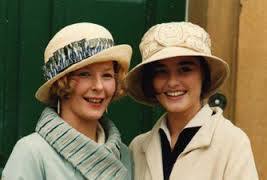 There's a couple of side stories: A handsome aviator who claims he's their brother. A playboy photographer with bad finances who loves the older sister, Beatrice. With him we learn about the new "frivolity" moving pictures. There's a cousin dabbling in illegal activities in a speak-easy. An aunt obsessed with society who finds herself OUT of it. A woman named Penelope--who got on my nerves something AWFUL and I'm so glad she seems to be leaving before season two--who is deeply involved in charity work. And I already said I couldn't stand her, but she did have some food for thought. And yet, some of work hard for our money, lady.
There's a couple of side stories: A handsome aviator who claims he's their brother. A playboy photographer with bad finances who loves the older sister, Beatrice. With him we learn about the new "frivolity" moving pictures. There's a cousin dabbling in illegal activities in a speak-easy. An aunt obsessed with society who finds herself OUT of it. A woman named Penelope--who got on my nerves something AWFUL and I'm so glad she seems to be leaving before season two--who is deeply involved in charity work. And I already said I couldn't stand her, but she did have some food for thought. And yet, some of work hard for our money, lady.In this season, we not only see HofE starting up but we also see Evangline grow from a somewhat spoiled (personality wise, not money_ child into a young woman with grand ideas. It was interesting to watch Beatrice struggle to step back and let Evie be an adult and also to watch their disagreements about clothes. There's a 13-year difference and it shows. The acting is superb. I was really quite lost in the story.
I'm liking it so far. If you're seeking a historical about strong women and have a preference for the twenties--while this doesn't hold a candle to the scandalous Phyrnne Fisher--it's worth the time and money.

Published on April 29, 2015 00:00
April 28, 2015
Is the Objectification of Women a Form of Terrorism? Dietland by @QueSaraiSera Makes One Wonder
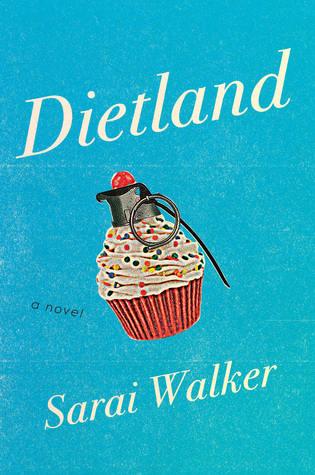 This is probably the most powerful novel I will read this year--heck, maybe in my life. It's thought evoking, daring, and if you're a woman whose knickers aren't already in a twist, they will be. Because this novel will make you think hard, about your body, how you view it, how men view it, and how the way men view it changes the way you view it. Do you want to be thin for yourself, to be healthy? Or do you just want to be....f*ckable? And if you truly are the latter, are you happy being objectified by men constantly?
This is probably the most powerful novel I will read this year--heck, maybe in my life. It's thought evoking, daring, and if you're a woman whose knickers aren't already in a twist, they will be. Because this novel will make you think hard, about your body, how you view it, how men view it, and how the way men view it changes the way you view it. Do you want to be thin for yourself, to be healthy? Or do you just want to be....f*ckable? And if you truly are the latter, are you happy being objectified by men constantly?There are two stories here. Plum is overweight and she lives her life as if she's attending a funeral everyday. (As was noted in that journal). She's put her life completely on hold; it won't really start until she's skinny. She has a closet full of dresses for her future self. She plans to marry when she's skinny. She plans so many things that she refuses to do now..she won't even try to do them now. Plum's life is on hold. Only thoughts of her skinny future and some anti-depressants are keeping her going.
A mysterious woman who follows her leads her to another group of women who begin a "plan" with her. At the end of five tasks, Plum will have to decide if she still wants the weight loss surgery or not.
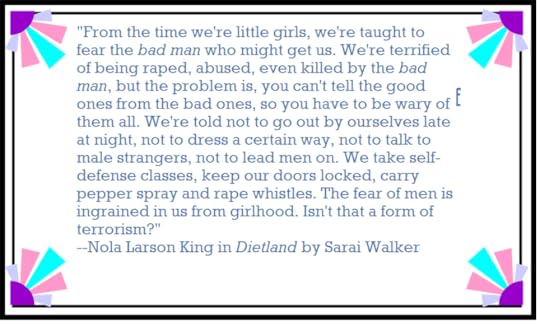 This entire story of Plum, her weight, and the way people treat her...makes the reader face many things they may or may not want to face. How we look at people and ourselves, how men treat skinny women versus larger women. How well do you really know the men in your life? Are you seeing their true side?
This entire story of Plum, her weight, and the way people treat her...makes the reader face many things they may or may not want to face. How we look at people and ourselves, how men treat skinny women versus larger women. How well do you really know the men in your life? Are you seeing their true side?And yea, though it's easier said than done, if you refuse to let the taunts and comments hurt you, you've taken away the power the commenters held over you.
Meanwhile, a female "terrorist" group branded "Jennifer" begins to get revenge on sex predators and other men who objectify women. Men who have raped, abused, etc, are suddenly falling from planes in the sky--without parachutes--or found dead in bags on the interstate.
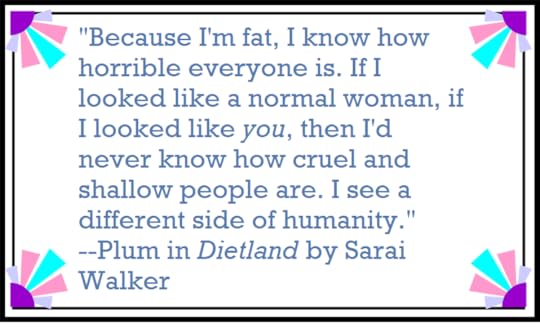 Despite the seriousness of terrorism, I thoroughly enjoyed how the women got revenge and began changing the world. Why should magazines not be covered with naked or half naked men? Who cares that they're uncomfortable with it? They've been doing it to us for decades. I found myself cackling with glee. "How you like it!!??" I kept laughing.
Despite the seriousness of terrorism, I thoroughly enjoyed how the women got revenge and began changing the world. Why should magazines not be covered with naked or half naked men? Who cares that they're uncomfortable with it? They've been doing it to us for decades. I found myself cackling with glee. "How you like it!!??" I kept laughing.And even better, this novel had humor, I laughed my butt off when Plum gets a wax. Some of the things her friends said also got chuckles.
The two story lines...didn't really tie together well. And yet, you can't have one without the other. Without Jennifer's doings, you may not really see where Plum is going wrong in her thinking.
I consider this a must read. Every woman should read it and pass it on to her daughter. I wouldn't even care that there are some F-bombs in it. (Moms, whether you like it or not, your daughter is going to be exposed to foul language one day.) It's there for a reason. This should be required literature.
I received this via Amazon Vine. Quotes may be somewhat different in the final version.

Published on April 28, 2015 00:00
April 27, 2015
"Just remember, seven-eleven, three-hundred and twenty-two pounds." @joelfishbane
 Sometimes I read a book that I just love--and not a moment too soon, especially after a month of duds (You readers know what I speak of, when every book you pick up stinks to high heaven and you begin to despair that you'll ever read another good book...and maybe the problem is you!) and I'm left speechless and don't really know what to say but, "I loved it!!! Read it! You don't want to miss this one!"
Sometimes I read a book that I just love--and not a moment too soon, especially after a month of duds (You readers know what I speak of, when every book you pick up stinks to high heaven and you begin to despair that you'll ever read another good book...and maybe the problem is you!) and I'm left speechless and don't really know what to say but, "I loved it!!! Read it! You don't want to miss this one!"I loved this novel and just like Anna Swan's husband's appendage makes the poor examining doctor feel wholly inadequate, I fear my review will be wholly inadequate, but I will do my best.
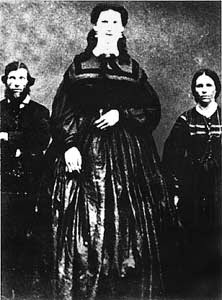 The real Anna Swan and her parents.
The real Anna Swan and her parents.Wiki CommonsFirst of all, this novel not only transported to me two different times and places in history, but it also made me laugh. From the mention of nervous farts to the witty offhand remarks between characters to the scenes themselves either in the tailor's shop involving a broken foot or the set of a Hollywood movie, the book fairly burst with surprise laughs.
Second, we learn about not one remarkable woman giant, but two, the first--Anna Swan--having been a real woman. I'm sure some artistic license was taken here, but we get the basics of the real woman, her size, her working for Barnum, her marriage and tours. Anna Swan is def my favorite of the two heroines. She's brave and amazing. She saves orphans, helps soldiers during the Civil War, all the while battling with her size. Her parts bring up issues of exploitation and even marriage. She's told she should marry someone like her. But what's so different about her really? She's may be large, may be called a giant lady, but really, she's just a lady. And we follow this lady from childhood in Canada (Pilgrims and New Yorkers will be shot! LOL) to "performing" in a museum to war to marriage, thru loss.
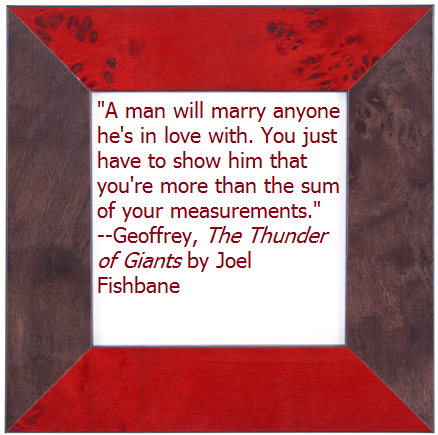 The second story is just after WWI, and another large lady deals with many of the same issues, combined with guilt over the death of her husband and feelings that things out of her control were caused by her. As another character later points out, she may be the reason for some decisions others made, but she didn't make their decisions for them. But she must realize that for herself.
The second story is just after WWI, and another large lady deals with many of the same issues, combined with guilt over the death of her husband and feelings that things out of her control were caused by her. As another character later points out, she may be the reason for some decisions others made, but she didn't make their decisions for them. But she must realize that for herself.So we have humor, history told in an entertaining way, two remarkable heroines, real-life struggles, food-for-thought, and all this told in a very engaging narrative.
If I were to complain about anything at all, it'd be that sometimes I became confused between the two heroines. At times the transition between 1930s and the late 1800s wasn't completely smooth, but I still loved this tale. In a time when authors are rewriting the same story over and over and over, to have finally picked up a novel completely and totally unique is a wonderful experience.
Thank you to Netgalley for a digital copy of this.


Published on April 27, 2015 00:00
April 26, 2015
Crafty Ladies, What Are You Working On? 4/26/15
I've been doing a lot of crafting lately. I haven't shared it and then I asked myself, "Why the hell not?"
So, it's Sunday, and the day was free, and so I've decided to share the projects I have going right now.
First of all, I just finished another clutch. This one is for a friend. When I asked her what she liked, she said, "Southwest, Aztec, the color teal."
And this is what I came up with. The pattern is from freepatterns.com and was originally intended for a basket. But I changed it up, obviously, and added a few beads--sewed them into the pattern.
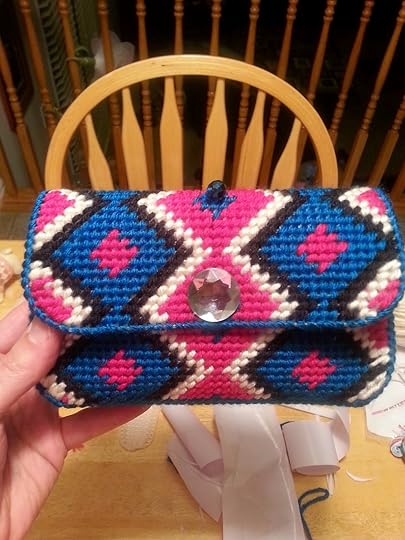

Ongoing projects:I just started this coin purse. It's a great idea from Stitch & Zip. They are sold in the craft catalogs for 15 bucks a piece, but I found them on Amazon for 12.99, free shipping (Prime). I've ordered more than one but this is the first I'm making. The coin purse unzips all the way around, enabling you to stitch the pre-colored canvas without impediment. Then you zip it up. As a coin purse, obviously, you only unzip the top part. This means no sewing is required, which is great for me because I can stitch all day, but sew? No way.
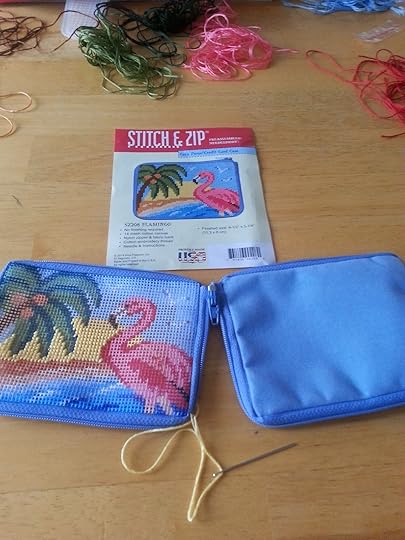
Also in progress: a clutch that came in a kit from Framous in Canada. I'm not crazy about this. It's taking me forever, especially compared to the clutch forms. It's ten-count and larger and the entire thing has to be stitched together--and there are three pieces to each side, a bottom, a flap, another piece, and the large front and back, which you see here. I'm already so tired of the sight of it. Yet, I will trudge on. I will say that what I like about this kit is that the charts are the exact size of the canvas. You can simply place the canvas on top of the chart and mark where you see the color. Faster than counting.
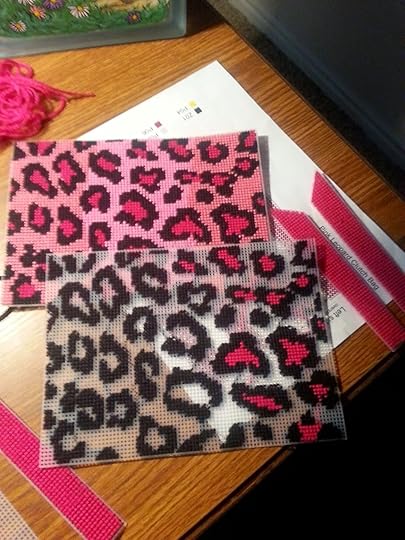
Hopefully I have a finished product to show you next Sunday. I've got a third project started, but it hasn't gotten far enough for you to see much. Meanwhile, what are YOU working on?
So, it's Sunday, and the day was free, and so I've decided to share the projects I have going right now.
First of all, I just finished another clutch. This one is for a friend. When I asked her what she liked, she said, "Southwest, Aztec, the color teal."
And this is what I came up with. The pattern is from freepatterns.com and was originally intended for a basket. But I changed it up, obviously, and added a few beads--sewed them into the pattern.


Ongoing projects:I just started this coin purse. It's a great idea from Stitch & Zip. They are sold in the craft catalogs for 15 bucks a piece, but I found them on Amazon for 12.99, free shipping (Prime). I've ordered more than one but this is the first I'm making. The coin purse unzips all the way around, enabling you to stitch the pre-colored canvas without impediment. Then you zip it up. As a coin purse, obviously, you only unzip the top part. This means no sewing is required, which is great for me because I can stitch all day, but sew? No way.

Also in progress: a clutch that came in a kit from Framous in Canada. I'm not crazy about this. It's taking me forever, especially compared to the clutch forms. It's ten-count and larger and the entire thing has to be stitched together--and there are three pieces to each side, a bottom, a flap, another piece, and the large front and back, which you see here. I'm already so tired of the sight of it. Yet, I will trudge on. I will say that what I like about this kit is that the charts are the exact size of the canvas. You can simply place the canvas on top of the chart and mark where you see the color. Faster than counting.

Hopefully I have a finished product to show you next Sunday. I've got a third project started, but it hasn't gotten far enough for you to see much. Meanwhile, what are YOU working on?
Published on April 26, 2015 00:00
April 25, 2015
The Reading Radar 4/25/2015 @PiaCCourtenay @janethynne
What grabbed my attention this week, why, and how did I come across it?
 I'd love more info about this one, which I spotted on Amazon while doing my quarterly "woman, pilot" search. Racing to Greet the Sun: Jerrie Mock and Joan Merriam Smith Duel to Become the First Woman to Fly Solo Around the World by Taylor Phillips
I'd love more info about this one, which I spotted on Amazon while doing my quarterly "woman, pilot" search. Racing to Greet the Sun: Jerrie Mock and Joan Merriam Smith Duel to Become the First Woman to Fly Solo Around the World by Taylor Phillips
Racing to Greet the Sun is the story of the race around the world that the world has forgotten.
In 1964, Jerrie Mock and Joan Merriam Smith found themselves in a duel to become the first "lady pilot" to circumnavigate the globe, alone - a feat which Amelia Earhart was unable to accomplish.
Along the way Jerrie overcame sandstorms, ice on her wings, smoke in her cockpit, and soldiers surrounding her plane when she unintentionally landed on a secret military base. Joan made it through a revolution in Brazil, mechanical failure over the Pacific and a cyclone in Australia.
By the time the duel was done, both women were able to claim victory. Read the book and find out why.
Is it a biography? Historical fiction?
***
Spotted on Netgalley and curious about, especially since it hints at the women's right to vote struggle... Paper Daisies by Kim Kelly. (LOOK at this GORGEOUS cover.)
 As 1900 draws to a close, Berylda Jones, having completed her university exams for entry to medicine is heading home to Bathurst for Christmas. Tragically, 'home' is where she and her beloved sister Greta live in terror, under the control of their sadistic Uncle Alec.
As 1900 draws to a close, Berylda Jones, having completed her university exams for entry to medicine is heading home to Bathurst for Christmas. Tragically, 'home' is where she and her beloved sister Greta live in terror, under the control of their sadistic Uncle Alec.
But this summer Berylda has a plan - borne out of desperation - to free herself and Greta from Alec for good, if she can only find the courage to execute it.
Then, on New Year's Eve, just as Alec tightens his grip over the sisters, a stranger arrives at their gate - Ben Wilberry, a botanist, travelling west in search of a particular native wildflower, with his friend, the artist Cosmo Thompson.
Ben is at first oblivious to what depravity lies beyond this threshold and what follows is a journey that will take him and Berylda, Greta and Cosmo, out to the old gold rush town of Hill End - a tumbledown place with its own dark secrets - in search of a means to cure evil and a solution to what seems an impossible situation.
Against the tumultuous backdrop of Australian Federation and the coming of the Women's Vote, Paper Daisies is a story of what it means to find moral courage, of a crime that must be committed to see justice done and a sweet love that grows against the odds.
***
Spotted on Edelweiss. I can't get enough of women dressing like boys in history. Li Jun and the Iron Road by Anne Tait.
 Adapted from the award-winning TV miniseries "Iron Road," starring Sam Neill and Peter O'Toole, the story of a woman whose search for herself helped shaped two nations. Set in the 1880s in southern China and the mountains of British Columbia, "Li Jun and the Iron Road" tells the story of a feisty street urchin nicknamed Little Tiger, who works in a fireworks factory and yearns to sail across the ocean to the country she knows as Gold Mountain. Sent by her dying mother to find her father, who had left years earlier, Little Tiger disguises herself as a boy and finds herself working on the railroad in Canada. When her deception leads to a forbidden love with a privileged son of a Canadian railroad tycoon, the results leave two worlds shaken.
Adapted from the award-winning TV miniseries "Iron Road," starring Sam Neill and Peter O'Toole, the story of a woman whose search for herself helped shaped two nations. Set in the 1880s in southern China and the mountains of British Columbia, "Li Jun and the Iron Road" tells the story of a feisty street urchin nicknamed Little Tiger, who works in a fireworks factory and yearns to sail across the ocean to the country she knows as Gold Mountain. Sent by her dying mother to find her father, who had left years earlier, Little Tiger disguises herself as a boy and finds herself working on the railroad in Canada. When her deception leads to a forbidden love with a privileged son of a Canadian railroad tycoon, the results leave two worlds shaken.
***And my one of my all-time favorite authors has new book coming out soon! Many of you will be pleased to know Christina Courtenay's third in the Japanese trilogy is releasing soon. I spotted this on her blog. The Jade Lioness
 Can an impossible love become possible?
Can an impossible love become possible?
Nagasaki, 1648
Temperance Marston longs to escape war-torn England and explore the exotic empire of Japan. When offered the chance to accompany her cousin and Captain Noordholt on a trading expedition to Nagasaki, she jumps at the opportunity. However, she soon finds the country’s strict laws for foreigners curtail her freedom.
On a dangerous and foolhardy venture she meets Kazuo, a ronin. Kazuo is fascinated by her blonde hair and blue eyes, but he has a mission to complete and he cannot be distracted. Long ago, his father was accused of a crime he didn’t commit – stealing a valuable jade lioness ornament from the Shogun – and Kazuo must restore his family's honour.
But when Temperance is kidnapped and sold as a concubine, he has to make a decision – can he save her and keep the promise he made to his father?
***
Spotted on Goodreads Giveaways.. I'm excited to see this because I've wanted to read this author's previous works but they are not available here in the States, not on Kindle. I finally just gave up on reading them. But this one is going to be available here! The Scent of Secrets by Jane Thynne. Note: it's book three, not book one. I asked the author on Goodreads and she said you don't have to read them in order, but be warned. I'm told this one takes place in 1938. Book one is 1933.
 Set in Europe, in 1938, during the tense run-up to war, and perfect for fans of Jacqueline Winspear, Charles Todd, Robert Harris, and Susan Elia MacNeal, this gripping historical novel features the half-British, half-German actress (and wholly covert spy) Clara Vine, who finds herself enmeshed in a dangerous game of subterfuge.
Set in Europe, in 1938, during the tense run-up to war, and perfect for fans of Jacqueline Winspear, Charles Todd, Robert Harris, and Susan Elia MacNeal, this gripping historical novel features the half-British, half-German actress (and wholly covert spy) Clara Vine, who finds herself enmeshed in a dangerous game of subterfuge.
The colorful, lively streets of Paris come as a welcome relief to Clara Vine after the dour countenance of Berlin, where bunkers and bomb shelters are being dug, soldiers march the streets in their high boots, and Jewish residents rush to make it home before curfew. Though Clara is in Paris to make a film, her true work is never far from her mind. Approached by a British intelligence officer, Clara is initially confounded by his request: Get close to Eva Braun and glean as much as she can about the Führer’s plans and intentions. Clara has already established friendships with several high-ranking Nazi wives, but Eva Braun is another matter altogether. Hitler keeps his “secret” girlfriend obsessively hidden, fiercely guarding their relationship as well as Eva’s delicate psychological state. From the gilded halls of the decadent City of Light to the cobbled, quaint streets of Munich, and even to the chilling, rarefied air of the Berghof, Hitler’s private mountaintop retreat, Clara flirts with discovery at every turn—and a dangerous, devious plot unfolds.
 I'd love more info about this one, which I spotted on Amazon while doing my quarterly "woman, pilot" search. Racing to Greet the Sun: Jerrie Mock and Joan Merriam Smith Duel to Become the First Woman to Fly Solo Around the World by Taylor Phillips
I'd love more info about this one, which I spotted on Amazon while doing my quarterly "woman, pilot" search. Racing to Greet the Sun: Jerrie Mock and Joan Merriam Smith Duel to Become the First Woman to Fly Solo Around the World by Taylor PhillipsRacing to Greet the Sun is the story of the race around the world that the world has forgotten.
In 1964, Jerrie Mock and Joan Merriam Smith found themselves in a duel to become the first "lady pilot" to circumnavigate the globe, alone - a feat which Amelia Earhart was unable to accomplish.
Along the way Jerrie overcame sandstorms, ice on her wings, smoke in her cockpit, and soldiers surrounding her plane when she unintentionally landed on a secret military base. Joan made it through a revolution in Brazil, mechanical failure over the Pacific and a cyclone in Australia.
By the time the duel was done, both women were able to claim victory. Read the book and find out why.
Is it a biography? Historical fiction?
***
Spotted on Netgalley and curious about, especially since it hints at the women's right to vote struggle... Paper Daisies by Kim Kelly. (LOOK at this GORGEOUS cover.)
 As 1900 draws to a close, Berylda Jones, having completed her university exams for entry to medicine is heading home to Bathurst for Christmas. Tragically, 'home' is where she and her beloved sister Greta live in terror, under the control of their sadistic Uncle Alec.
As 1900 draws to a close, Berylda Jones, having completed her university exams for entry to medicine is heading home to Bathurst for Christmas. Tragically, 'home' is where she and her beloved sister Greta live in terror, under the control of their sadistic Uncle Alec.But this summer Berylda has a plan - borne out of desperation - to free herself and Greta from Alec for good, if she can only find the courage to execute it.
Then, on New Year's Eve, just as Alec tightens his grip over the sisters, a stranger arrives at their gate - Ben Wilberry, a botanist, travelling west in search of a particular native wildflower, with his friend, the artist Cosmo Thompson.
Ben is at first oblivious to what depravity lies beyond this threshold and what follows is a journey that will take him and Berylda, Greta and Cosmo, out to the old gold rush town of Hill End - a tumbledown place with its own dark secrets - in search of a means to cure evil and a solution to what seems an impossible situation.
Against the tumultuous backdrop of Australian Federation and the coming of the Women's Vote, Paper Daisies is a story of what it means to find moral courage, of a crime that must be committed to see justice done and a sweet love that grows against the odds.
***
Spotted on Edelweiss. I can't get enough of women dressing like boys in history. Li Jun and the Iron Road by Anne Tait.
 Adapted from the award-winning TV miniseries "Iron Road," starring Sam Neill and Peter O'Toole, the story of a woman whose search for herself helped shaped two nations. Set in the 1880s in southern China and the mountains of British Columbia, "Li Jun and the Iron Road" tells the story of a feisty street urchin nicknamed Little Tiger, who works in a fireworks factory and yearns to sail across the ocean to the country she knows as Gold Mountain. Sent by her dying mother to find her father, who had left years earlier, Little Tiger disguises herself as a boy and finds herself working on the railroad in Canada. When her deception leads to a forbidden love with a privileged son of a Canadian railroad tycoon, the results leave two worlds shaken.
Adapted from the award-winning TV miniseries "Iron Road," starring Sam Neill and Peter O'Toole, the story of a woman whose search for herself helped shaped two nations. Set in the 1880s in southern China and the mountains of British Columbia, "Li Jun and the Iron Road" tells the story of a feisty street urchin nicknamed Little Tiger, who works in a fireworks factory and yearns to sail across the ocean to the country she knows as Gold Mountain. Sent by her dying mother to find her father, who had left years earlier, Little Tiger disguises herself as a boy and finds herself working on the railroad in Canada. When her deception leads to a forbidden love with a privileged son of a Canadian railroad tycoon, the results leave two worlds shaken.***And my one of my all-time favorite authors has new book coming out soon! Many of you will be pleased to know Christina Courtenay's third in the Japanese trilogy is releasing soon. I spotted this on her blog. The Jade Lioness
 Can an impossible love become possible?
Can an impossible love become possible?
Nagasaki, 1648
Temperance Marston longs to escape war-torn England and explore the exotic empire of Japan. When offered the chance to accompany her cousin and Captain Noordholt on a trading expedition to Nagasaki, she jumps at the opportunity. However, she soon finds the country’s strict laws for foreigners curtail her freedom.
On a dangerous and foolhardy venture she meets Kazuo, a ronin. Kazuo is fascinated by her blonde hair and blue eyes, but he has a mission to complete and he cannot be distracted. Long ago, his father was accused of a crime he didn’t commit – stealing a valuable jade lioness ornament from the Shogun – and Kazuo must restore his family's honour.
But when Temperance is kidnapped and sold as a concubine, he has to make a decision – can he save her and keep the promise he made to his father?
***
Spotted on Goodreads Giveaways.. I'm excited to see this because I've wanted to read this author's previous works but they are not available here in the States, not on Kindle. I finally just gave up on reading them. But this one is going to be available here! The Scent of Secrets by Jane Thynne. Note: it's book three, not book one. I asked the author on Goodreads and she said you don't have to read them in order, but be warned. I'm told this one takes place in 1938. Book one is 1933.
 Set in Europe, in 1938, during the tense run-up to war, and perfect for fans of Jacqueline Winspear, Charles Todd, Robert Harris, and Susan Elia MacNeal, this gripping historical novel features the half-British, half-German actress (and wholly covert spy) Clara Vine, who finds herself enmeshed in a dangerous game of subterfuge.
Set in Europe, in 1938, during the tense run-up to war, and perfect for fans of Jacqueline Winspear, Charles Todd, Robert Harris, and Susan Elia MacNeal, this gripping historical novel features the half-British, half-German actress (and wholly covert spy) Clara Vine, who finds herself enmeshed in a dangerous game of subterfuge.The colorful, lively streets of Paris come as a welcome relief to Clara Vine after the dour countenance of Berlin, where bunkers and bomb shelters are being dug, soldiers march the streets in their high boots, and Jewish residents rush to make it home before curfew. Though Clara is in Paris to make a film, her true work is never far from her mind. Approached by a British intelligence officer, Clara is initially confounded by his request: Get close to Eva Braun and glean as much as she can about the Führer’s plans and intentions. Clara has already established friendships with several high-ranking Nazi wives, but Eva Braun is another matter altogether. Hitler keeps his “secret” girlfriend obsessively hidden, fiercely guarding their relationship as well as Eva’s delicate psychological state. From the gilded halls of the decadent City of Light to the cobbled, quaint streets of Munich, and even to the chilling, rarefied air of the Berghof, Hitler’s private mountaintop retreat, Clara flirts with discovery at every turn—and a dangerous, devious plot unfolds.
Published on April 25, 2015 00:00
April 24, 2015
Ten Questions from Tara: Interview with Suzanne Munshower @expatina
 Welcome. You’re here to promote Younger, a thriller. Tell me, please, what was the inspiration behind this story? How did it come to you?
Welcome. You’re here to promote Younger, a thriller. Tell me, please, what was the inspiration behind this story? How did it come to you?Readers, here's a blurb for you real quick:
When PR pro Anna Wallingham gets dumped by her last client, she finds herself running out of options in LA, where looks trump experience. Desperate to prove she is still relevant, the fiftysomething accepts a shady job offer from Pierre Barton, secretive billionaire owner of Barton Pharmaceuticals. Isolated in a facility outside London, she agrees to test a new top-secret product guaranteed to make her look thirty years younger. Anna is starting to look on the outside the way she feels on the inside: ageless. But she soon discovers that her predecessor died under mysterious circumstances, leading her to research just who stands to gain—and lose—with this miraculous product. When Pierre drops dead in front of her, she takes off on a dangerous journey across Europe hoping to stay alive long enough to uncover the truth.
With the hard-won knowledge that younger isn’t always better, Anna is determined to escape and reclaim her life before it’s too late.
Two things happened that combined to make me dream up a mystery about age. First, I saw a French TV documentary on a woman named Madeleine Castaing, filmed when she was in her eighties and renowned in Paris as a daring interior decorator. She was garish looking, yet mesmerizing. Once a great beauty, she was determined to stay beautiful—at least to herself. She painted big eyelashes directly onto the skin around her eyes, wore an obviously fake auburn wig, and used a glaringly visible black chin strap to lift her aged neck. That documentary haunted me.
About a year or two later, I was considering what work I would do if I returned to the States more than a decade in Europe. A friend asked, couldn’t I get a senior in-house PR position, work I had done in the past. I was stunned that it had never occurred to her, as a non-corporate person, that women over fifty are pretty much unemployable. Those two ideas became the germ of Younger.
We focus a lot on heroines here on Book Babe. Tell me what makes your heroine strong.
Anna is far from perfect, but she’s also indomitable. She swallows her bitter medicine when she loses her only public relations account and keeps up a good front. Still, she’s deeply worried about her future, enough so she can’t consider the lifeline being thrown to her in the form of an eccentric job offer—in spite of suspecting from the start that it’s all too good to be true. But she’s tough enough that, even when she’s in grave danger, even knowing people have died, she stays the course to get to the truth.
Do you see any of yourself in her?
My friends all call me the one who lands on her feet, and they know that’s because I soldier on and never give up other than briefly. I’ve had more ups and down than some pilots, so in that respect, Anna is a lot like me, And I fell back upon a lot of my own experiences when Ann’s on the run: she walks not only in Kafka’s footsteps, but in my own as well.
Was there any particular part of this story that was the hardest for you to write? Tell me why.
The technical part was challenging. I wanted readers unfamiliar with computers and cellphones to grasp what was going on without turning the novel into Digital Security for Dummies!
What kind of research did you do when you penned this novel? Did anything surprising come up in your search?
I did a lot technical and intelligences services research because I’m loath to make up anything that might fool the reader into believing things that aren’t verifiably true. The only surprising thing, I’d say, is that when I traveled after I had written the first and second drafts, I was shocked to be looking at places I had been before—say, Café Louvre in Prague, Piazza del Popolo in Rome, Marks and Spencer in London—and now seeing them through Anna’s eyes. I was meeting friends at Café Louvre and was disappointed that “Anna’s table” was taken so we couldn’t sit there!
What would you like readers to gain from reading your book? Is there a strong moral? Do you hope they will laugh, learn something about a particular subject/person, ponder a point?
I’ve been very happy to see how many reader reviews mention a new appreciation and acceptance of growing older. Anna was never really desperate to stay young—she makes the choice to take thirty years off her looks so she can survive financially—but like most women her age who are at all fashionable, she frets over the lines in her face and the aging of her body. She changes a great deal during her Younger experience, and the most important change is the one taking place in her mind. We women need to learn the wisdom of self-acceptance, accepting not just one’s age but one’s past and one’s present, because so many of us have been brought up to fixate on our looks or our weight or impressing others, as if hose things are what make us valuable or lovable.
Your book takes place in so many cities, both in the United States and Europe. If I were a tourist, what would you recommend I travel to see?
I love to travel, so I would say, “Everywhere.” I would love to inspire people to travel as much as they can. I would say, you must visit Paris and Prague for the romance, architecture, and history, London because it’s enough like the US to be comfortable but also refreshingly alien and European, Berlin because it is the future, and Rome because it’s always like waking up in the middle of a movie being shot. I remember the first time I went there, sitting in an outdoor café with an espresso, thinking, I can’t possibly be having a coffee directly across the street from the Colisseum!
If you could time travel to absolute any time and place in history, where and when would you go and what is it that draws you to this time period? What would you do whilst there?
I think I would go to the period I tend to read about most, the time between the World Wars. It’s such a striking time in history with so many changes going on and such progress being made for women. I’d love to wander the Left Bank of Fitzgerald and Hemingway, drinking vermouth cassis in cafes and buying books in stalls along the Seine. I can see the attraction of writing historical fiction. The book I’m working on now is set in Las Vegas in the 1970s, and it’s taking me back there. It was an amazing time to be in an amazing place.
What’s the one thing you hope to accomplish before you die? Your main goal?
My main goal is simply to keep on keeping on, to keep on writing, keep on traveling, keep enjoying the party until it ends.
I’m a dog mom, so I always ask this. Do you have pets? If so, tell me about them and do provide pictures.
 I’ve had three amazing female cats, the last of which died last spring in Berlin at the age of 22. I am sending her picture because she was really a soulmate. But the two previous cats were also very special and loving and never skittish. They all had such similar personalities and they, too, lived to a good age, 17 and 18. I will get another. Having moved relatively recently, I’m just not ready yet.
I’ve had three amazing female cats, the last of which died last spring in Berlin at the age of 22. I am sending her picture because she was really a soulmate. But the two previous cats were also very special and loving and never skittish. They all had such similar personalities and they, too, lived to a good age, 17 and 18. I will get another. Having moved relatively recently, I’m just not ready yet.Thank you so much for joining us. I've really enjoyed your answers. I'm adding Berlin to my "to-visit" list. And I am amazed that you had a cat that lived to be 22. How incredibly blessed you are to have her as a companion so long!
***
 Suzanne Munshower is a former waitress, short-order cook, go-go girl, movie extra, celebrity interviewer, journalist, fashion columnist, advertising copywriter, and beauty industry publicist. The author of numerous fiction and nonfiction books, she’s lived in New York, Los Angeles, San Juan, St. Thomas, London, Berlin, and Città di Castello, Italy. She currently resides in Las Vegas.
Suzanne Munshower is a former waitress, short-order cook, go-go girl, movie extra, celebrity interviewer, journalist, fashion columnist, advertising copywriter, and beauty industry publicist. The author of numerous fiction and nonfiction books, she’s lived in New York, Los Angeles, San Juan, St. Thomas, London, Berlin, and Città di Castello, Italy. She currently resides in Las Vegas.
Published on April 24, 2015 00:00
April 23, 2015
Indiscretion by Hannah Fielding
 It's 1950, and a British woman and novelist is going to meet her family in Spain for the first time. She's twenty-five and though she writes about love, she's yet to experience it herself. Her Spanish family is...strange...to the say the least. They are wealthy; they tolerate a wild group of Gypsies on their land; and all the women are terrible bitches, it seems, except Esmeralda, who is just a coward.
It's 1950, and a British woman and novelist is going to meet her family in Spain for the first time. She's twenty-five and though she writes about love, she's yet to experience it herself. Her Spanish family is...strange...to the say the least. They are wealthy; they tolerate a wild group of Gypsies on their land; and all the women are terrible bitches, it seems, except Esmeralda, who is just a coward.And Alexandra is just thrown into the middle of all their drama--the drama pretty much surrounding the incredibly good looking Salvador who is just oh so seductive...and crazy. He's got a secret baby, a fiance, and yet lusts after his cousin one min and tells her to go home five min later. That's pretty much the first 40%.
I wanted to like this book. I normally really enjoy the Spanish setting and the heroine is very independent. But I didn't like it. I abandoned at the halfway point, as the most exciting thing at that point was that someone shot an arrow at the heroine. I was actually cheering that something besides Salvador drama and lust was going on.
Things that put me off:
--It does NOT feel like 1950. Not even close. The novel mentions how backward Spain is and that they are still recovering from war, but it felt like Victorian days, even the way they dress. And while the Spanish may be stuck in the past, for Alexandra, a British lass, to be that way...in 1950??? No.
 --The hero is a bipolar and runs hot then cold, hot then cold, and frankly, treats the heroine like crap. Her pining for this guy did her no favors with me.
--The hero is a bipolar and runs hot then cold, hot then cold, and frankly, treats the heroine like crap. Her pining for this guy did her no favors with me.--It's predictable. The costume, the man on the pier...I saw it all coming from the very first.
--The hero again...is obviously a man whore and Alexandra is this virginal angel...I hate that.
--Did I mention all the women are bitches? The grandmother, the gypsy, the stepmother, the stepsister, the Isabel lady. Everyone but the heroine and the maid Agusta pretty much.
--After all the cold reception, why didn't Alexandra just go home? What's keeping her in Spain? Her father never talks to her after the first day. I get she is always up for a challenge and fights for what she wants, but this guy is not worth it.
I just didn't like this. But I thank the publisher for sending me a digital file for review.

Published on April 23, 2015 00:00
April 22, 2015
Q&A With Ona Russell, Author of the Sarah Kaufman Historical Mysteries @Ona__russell
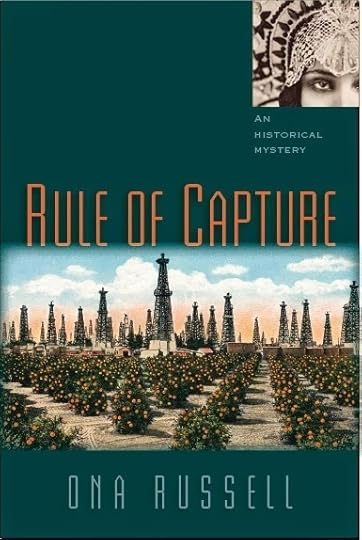 Set in Los Angeles in 1928, Rule of Capture finds Ohio court officer and civic trailblazer Sarah Kaufman at the trial of C. C. Julian, a suave huckster who knowingly over-issued stock in his petroleum company. Swindling thousands out of their savings, Julian and his cohorts were notorious in their day, and as one of their victims, Sarah is in the city to see that justice is served. But when a former acquaintance, the beautiful Rita Fuentes Bradford, is murdered, Sarah finds herself drawn into a search for Rita’s killer.
Set in Los Angeles in 1928, Rule of Capture finds Ohio court officer and civic trailblazer Sarah Kaufman at the trial of C. C. Julian, a suave huckster who knowingly over-issued stock in his petroleum company. Swindling thousands out of their savings, Julian and his cohorts were notorious in their day, and as one of their victims, Sarah is in the city to see that justice is served. But when a former acquaintance, the beautiful Rita Fuentes Bradford, is murdered, Sarah finds herself drawn into a search for Rita’s killer. Plunged into a tense, ethnic tug-of-war between the Jewish and Mexican communities in the “melting pot” of early L.A., Sarah becomes involved with the handsome and powerful Carlos Martinez, a Chicano man both living the American Dream and engaged in subversive activity. While the relationship between Sarah and Carlos heats up, Sarah’s lover, journalist Mitchell Dobrinski, decides to visit Los Angeles to report on the trial and keep an eye on Sarah. But Mitchell gets more than he bargains for, learning not only of Sarah’s infidelity, but her discovery of a cover-up that threatens to break the city at the seams. Laced with historical details from 1920s Los Angeles—when oil was booming, Hollywood was young, and Tijuana was the frontier—the story also shines a light on the ruling class corruption and ethnic prejudices that continue to this day. In providing a tantalizing glimpse into Southern California’s past, Rule of Capture holds a mirror up to its present.
Like the highly-praised O’Brien’s Desk and The Natural Selection, Rule of Capture is a rich, layered narrative that challenges simple assumptions of right and wrong. It is a must-read for historical mystery lovers who crave evocative details, engaging characters, and sociological themes that center on race, class and gender, particularly on the power these categories confer or deny. Masterfully written and researched, Rule of Capture introduces readers through actual courtroom testimony to the individuals behind the once infamous C. C. Julian oil scandal, while drawing us back into the world of Sarah Kaufman and her unending quest for justice.
“Los Angeles is a city of contradictions,” said Russell, “built on optimism and despair, settlement and displacement. It is a city of dreams and nightmares, renewal and dissolution, tolerance and bigotry. And as many writers before me have discovered, it is a city of hidden crimes, and thus a ripe setting for a mystery. It is one of the darkest of these crimes that forms the basis of my story and that teaches my protagonist—a real historical figure who I adopted as my fictional sleuth—that a victim of injustice can also be a victimizer.”
***
1. Rule of Capture is a legal mystery that takes place in Los Angeles in the 1920s. What inspired you to write a historical novel set in that time and place?
As for the era, it really found me. I situated the story in the 1920s because I was led there by the news clippings that formed the basis of my first book. After becoming fascinated with the period in general, however, especially after realizing how similar it was to our own time, I decided to stay there. Los Angeles was another matter. In trying to figure out the setting of my next book—I had initially planned a series that would include every state in the Union!—I came across a little known but incredibly important court trial held in L.A. in 1928. This led to other discoveries that I thought could provide interesting plot twists. Plus, my grandfather owned a shoe store in L.A. that I decided to weave into the narrative. Also, I was born in L.A, my daughter and parents live in the city, and it was a relatively close place to do research. So, voilà! Los Angeles!
2. Like Rule of Capture, your first two novels, O’Brien’s Desk and The Natural Selection, feature a real person, juvenile social worker and counselor Sarah Kaufman, as their heroine. What’s special about Sarah and how did you come to choose her as the star sleuth for your mystery series?
I was introduced to Sarah while doing research for O’Brien’s Desk. O’Brien was my husband’s grandfather and a prominent judge in 1920s Ohio. He frequently appeared in newspapers of the day, accompanied by his court appointee, Sarah Kaufman. I was immediately struck by Sarah, a Jewish woman who had made a name for herself in a male-dominated and gentile environment. She was a working professional at a time when few women left the home and a civic leader involved in all sorts of Progressive causes. But she also lived with her siblings, never married, and was an aspiring writer. This gave her a complexity that I thought could be developed. The more I read and imagined, the more convinced I became of her fictional possibilities. As a Jewish woman myself, I identified with her, so much so that I laid flowers on her grave to thank her for inspiring me. In life she was a crusader for justice; in fiction she’s the same. And I’m proud to say that as a result of my first book, she (the real Sarah Kaufman) was inducted into the Toledo Civic Hall of Fame.
3. There are strong elements of feminism and civil rights, especially with regard to religion and race, in all of your novels. What made you decide to pursue these thematic issues in your historical series and in this new novel?
Well, I’d have to say that it’s a combination of personal experience, education and history. I come from a family that values diversity and human rights. I approach the world from this perspective, and when I encounter opposition, I react. With respect to religion in particular, I’ve experienced my fair share of intolerance, and my reaction has taken many forms, including writing. Writing is for me a way to work through these experiences, to lay them bare and alter the narrative to my liking. Since the 1920s saw the rise of the KKK and all manner of bigotries, it’s natural, given my bent, that I would be drawn to these topics. My academic training was also a factor in my interest in such themes as it both exposed me to the pervasiveness of intolerance and taught me the importance of examining the context in which it occurs.
4. What do you find the most fascinating about the historical genre?
Emily Dickinson put it best: “Tell all the Truth but tell it Slant.” History is a powerful form of knowledge, but it is often told dryly and with a limited focus. I like the ability to bend history, to tell it “at a slant,” to be as faithful as I can to the facts but even more so to truth. I like research and getting the details right. But I love bringing unknown or underappreciated people and events to life. To do that, you sometimes have to fill in the missing pieces. Historical fiction gives you the permission to do so, as long as what you construct is consistent with the character and the time. I really believe that this kind of excavation and reimagining of the past is my calling. I feel most alive when I’m involved in the process of resurrecting the dead. The historical genre also allows me to teach about the past, to show its correspondences to the present, for instance, while entertaining with (hopefully) a compelling plot.
5. What would you like readers to remember most about you and your books?
Hmm. I guess that I take my writing seriously, that I work very hard to have the stories ring true. I promise readers that I will present them with some historical facts that they’ve probably never heard of before. Also, although I’m a mystery writer and proud of it, I’m not a formulaic one. I want readers to remember that there are no simple answers, and my books don’t offer any. But I value readers’ opinions and am open to their criticism. Well, to a point. To be absolutely honest, I want to be able to say, in the words of actress Sally Field: “You like me!”
6. Are you working on a new Sarah Kaufman novel and, if so, what can you tell us about it?
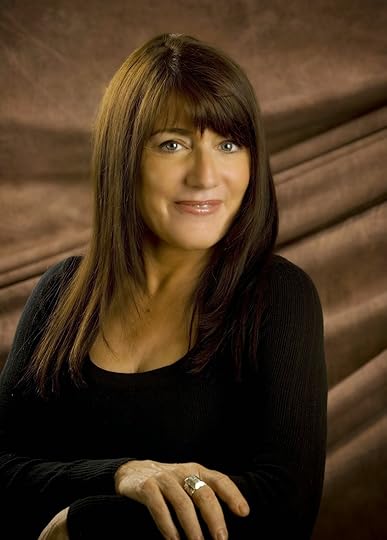 Yes and no. Sarah will be a character in the next book, but not the protagonist. She’ll be older and act as a kind of adviser. The story will take place in the 1940s, during WWII. And that’s about all I can say without giving away a critical piece of Rule of Capture.
Yes and no. Sarah will be a character in the next book, but not the protagonist. She’ll be older and act as a kind of adviser. The story will take place in the 1940s, during WWII. And that’s about all I can say without giving away a critical piece of Rule of Capture.***
Russell holds a Ph.D. in literature from the University of California, San Diego and is a credentialed mediator. Teaching for years at various colleges, she created courses that combined her interdisciplinary interests, including Literature and the Law, a topic on which she has written and spoken extensively. Russell was born in Los Angeles and now resides with her husband in Solana Beach, California.
For more information on the author or Rule of Capture, please visit www.onarussell.com.
Published on April 22, 2015 00:00



